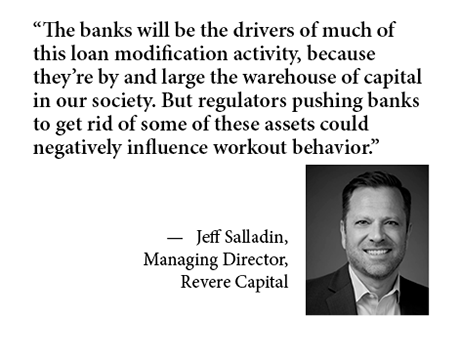Following the financial markets crash 15 years ago, banks and other lenders began working with commercial real estate (CRE) borrowers who had run into trouble. Solutions included loan extensions, loan sales, recapitalizations and foreclosures.
Today lenders are pulling out the playbook again.
“We have seen a huge number of loan workout deals come across our desk,” says Jeff Salladin, a managing director with Dallas-based private debt fund Revere Capital. “Any lender that holds loans on their books is seeing the same thing.”
Back in 2008, dodgy and highly leveraged residential and CRE loans — along with the emergence of exceedingly risky debt derivatives created by Wall Street — eventually crashed, causing the credit market to collapse. Today credit is still available, but the cost of it has spiked over the last 18 months.
Consequently, many commercial properties owners have seen values plummet, making it difficult to find refinancing. The Federal Deposit Insurance Corp.’s (FDIC) imminent auction of Signature Bank’s $33 billion in commercial property loans and other assets is expected to attract bids as much as 40 percent below face value, according to The Wall Street Journal.
That’s just the latest gloomy bellwether regarding CRE values and underscores the predicament of many property investors. As an example, a borrower that used $7 million in debt to finance the acquisition and renovation of an asset valued at $10 million two or three years ago may discover that its value has dropped to $8 million when it’s time to refinance, Salladin says.
Options for that borrower include working with the lender to extend or modify the loan, which in many cases means finding equity, preferred equity or mezzanine debt to balance out the leverage. Alternatively, the borrower could sell the asset and accept a reduced return or hand the keys to the lender either voluntarily or through a foreclosure. Short sales — sales in which the price fails to cover the loan balance — are another possibility.
“The situation has affected borrowers across all property categories, although it’s probably least prevalent in the multifamily space,” Salladin remarks. “There’s still a lot of demand for apartments, so those deals are a little easier to solve.”
Mixed Messages
Banks in particular are receiving encouragement to accommodate stressed borrowers. In June, the FDIC, Federal Reserve and other financial regulators updated guidance related to a policy originally crafted in 2009 to deal with troubled loans. In a statement, the regulators call for banks to work “prudently and constructively with creditworthy borrowers during times of financial stress.”
But regulators are also increasing their scrutiny of banks that hold CRE or construction loans that exceed risk-based total capital thresholds — generally 300 percent for CRE loans and 100 percent for construction loans. Some 505 banks surpassed the threshold in the second quarter, a year-over-year increase of 50 percent, according to S&P Global Market Intelligence. Meanwhile, big and small banks alike have set aside billions of dollars for impairment charges, non-performing loans and other losses.
“The banks will be the drivers of much of this loan modification activity, because they’re by and large the warehouse of capital in our society,” Salladin points out. “But regulators pushing banks to get rid of some of these assets could negatively influence workout behavior.”
Finding a Solution
Private debt funds like Revere, he counters, have more flexibility to work with borrowers because they don’t face the same regulatory pressures. The firm is finalizing one loan modification in which the borrower is using additional debt-free collateral to secure the note, which has improved Revere’s basis by spreading the loan over two properties, Salladin explains. In another instance, a multifamily borrower brought in around $2 million in fresh equity to rebalance a loan.
Revere so far has yet to foreclose on a property since the current banking crisis began and sees that option as a last resort, Salladin mentions. Plus, how quickly states process foreclosures varies. And the longer it takes to dispose of an asset, the lower a lender’s internal rate of return is going to be, he adds.
While borrowers who have short-term adjustable-rate loans have been hit hardest, uncertainty also surrounds the ability of borrowers with long-term fixed-rate debt to refinance. “A borrower might be able to refinance a $7 million loan on property that has held its original $10 million value,” Salladin says, “but the question is whether the cash flow can cover today’s costlier debt.”
Regardless in which situation borrowers find themselves, the best chance to affect a workout comes down to communication — and the earlier, the better, Salladin advises. “If you wait to talk to your lender until the day before your loan matures, it’s probably not going to end well,” he says. “Open dialogue with your lender well ahead of time is golden.”
— By Joe Gose. Revere Capital is a content partner of REBusinessOnline. For more information about the content partner program, click here.
Certain information herein reflects the opinions, estimates and projections of Revere Capital, an Investment Adviser registered with the U.S. Securities & Exchange Commission. All information provided is for informational purposes only and should not be deemed investment advice or a recommendation to purchase or sell any particular security, and no representation is made that expectations will be achieved. The opinions contained herein are based on what Revere Capital believes to be reasonable and accurate information that may have been provided by industry participants, research and analytics providers, and other primary and secondary sources.


